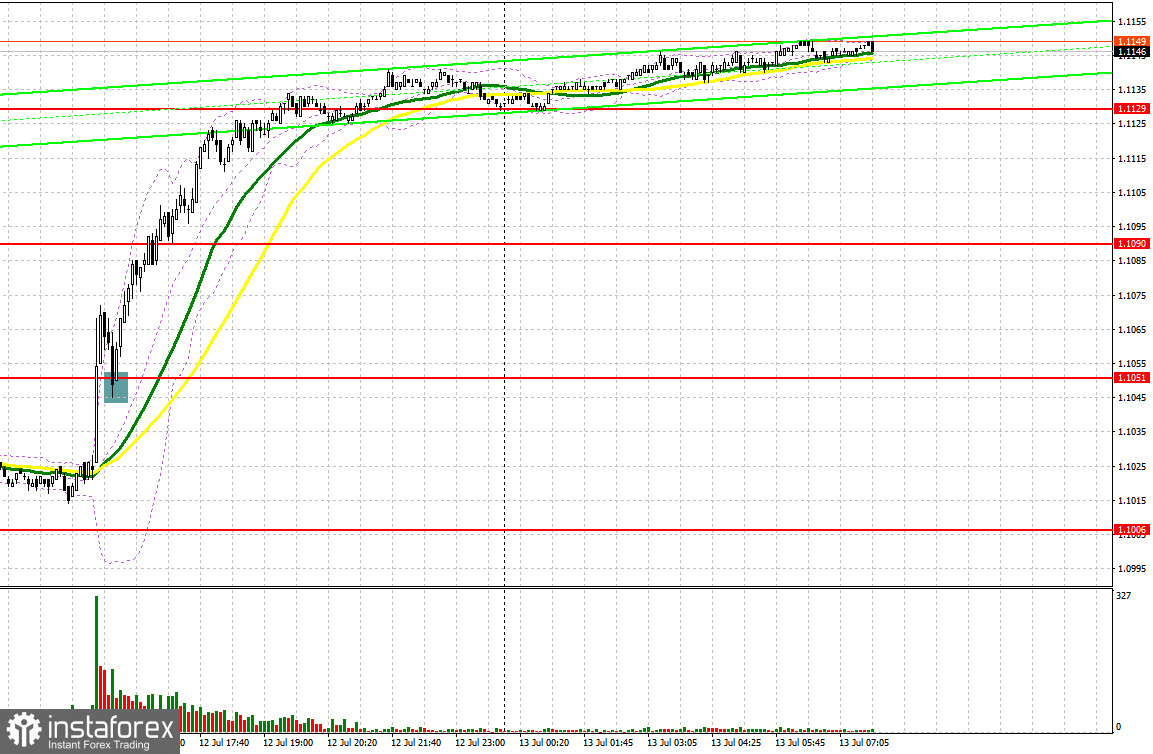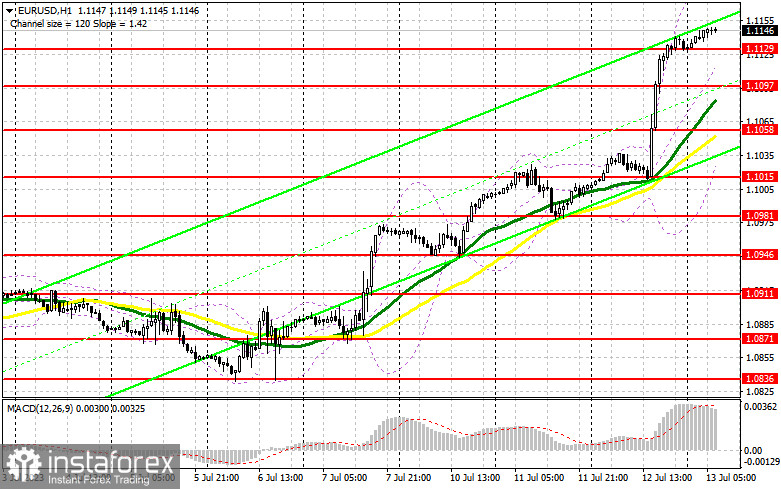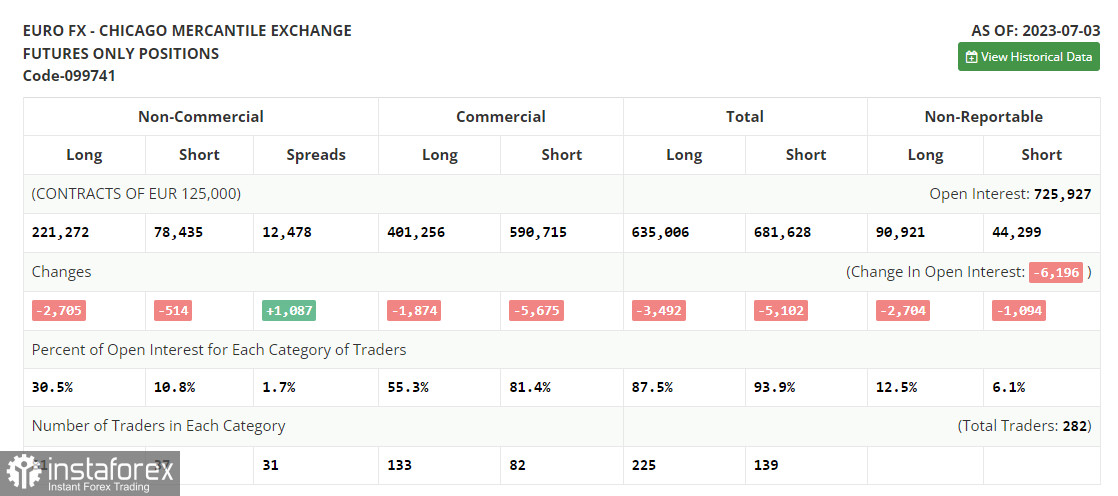Yesterday, the euro/dollar pair formed a good entry signal. Let's have a look at the 5-minute chart. In my morning review, I mentioned the level of 1.1016 as a possible entry point. Given that in the first half of the day, volatility was just within 17 pips, we could hardly find any entry points. Later in the day, a breakout of 1.1051 and its retest created a nice entry point into long positions, resulting in an upward movement of more than 100 pips. This was possible thanks to a sharp decrease in consumer prices in the US.

For long positions on EUR/USD:
The active slowdown of inflationary pressure in the United States has caused a weakening of the dollar against the European currency. This has significantly dampened market expectations and increased the possibility of the Federal Reserve winding down its high interest rate policy. In the first half of the day, an interesting economic forecast will be released by the European Commission and the ECB's report on monetary policy meeting will also be published. All of this favors the European currency. An increase in industrial production in the eurozone will only strengthen the positions of buyers.
If the reaction to the data is negative, it would be better to enter the market in the first half of the day only after a decline and a false breakout around the intermediate support 1.1127. This will signal a buying opportunity that may potentially continue the uptrend, leading to a retest of a resistance level at 1.1174. Its breakout and a downward retest will strengthen the demand for the euro, providing a chance for the bulls to reach a new yearly high at 1.1227. The ultimate target remains the area of 1.1271 where I will be taking profit. In the scenario of a decline in EUR/USD and the absence of buyers at 1.1129, the pressure on the pair will increase. Therefore, only the formation of a false breakout around the next support level at 1.1097 will signal a buying opportunity for the euro. I will open long positions immediately on a rebound from the low of 1.1058, keeping in mind an upward correction of 30-35 pips within the day.
For short positions on EUR/USD:
Sellers are unlikely to rush back into the market, especially amid a strong rise in demand for risk assets driven by expectations of diverging monetary policies between the ECB and the Fed. Bears are likely to focus on defending the nearest resistance at 1.1174. Otherwise, it will be challenging for them to avoid further bullish pressure. I will enter at this level only after a rise and then a false breakout, which will signal a selling opportunity with the prospect of a decline towards the support level of 1.1129. I expect to see larger buyers emerging at this level. A consolidation below this range, as well as its upward retest on the back of downbeat eurozone data, will pave the way to 1.1097 where the moving averages support the bulls. This will indicate a significant correction in the euro, which could revive buyers' appetite. The lowest target will be the area of 1.1058 where I will be taking profit.

In the event of an upward movement in EUR/USD during the European session and the absence of bears at 1.1174, which is quite possible considering the recent fundamental background, bulls will continue to build an upward trend. In such a case, I will postpone short positions until the price hits the next resistance at 1.1227. Selling can also be considered there, but only after an unsuccessful consolidation. I will open short positions immediately on a rebound from the high of 1.1271, targeting a downward correction of 30-35 pips.
COT report:
The Commitments of Traders report for July 3 recorded a fall in both long and short positions, leaving the market's balance almost unchanged. The released US labor market data indicates the first signs of cooling, which plays in favor of buyers of risk assets who anticipate further aggressive steps from their central banks, unlike the Federal Reserve. Many believe that the expected rate hikes by the Fed have already been priced into the quotes, and any data indicating a decrease in price pressure could lead to a larger sell-off in the US dollar. In the current conditions, buying the euro on pullbacks remains the optimal medium-term strategy. The COT report indicates that long positions of the non-commercial group of traders decreased by 2,705 to 221,272 while short positions fell by 514 to 78,435. At the end of the week, the overall non-commercial net position slightly decreased to 142,837 compared to the previous reading of 145,028. The weekly closing price dropped to 1.0953 from 1.1006.

Indicator signals:
Moving Averages
Trading above the 30- and 50-day moving averages indicates an uptrend in the euro.
Please note that the time period and levels of the moving averages are analyzed only for the H1 chart, which differs from the general definition of the classic daily moving averages on the D1 chart.
Bollinger Bands
In case of a decline, the lower band of the indicator at 1.1058 will act as support.
Description of indicators:
• A moving average of a 50-day period determines the current trend by smoothing volatility and noise; marked in yellow on the chart;
• A moving average of a 30-day period determines the current trend by smoothing volatility and noise; marked in green on the chart;
• MACD Indicator (Moving Average Convergence/Divergence) Fast EMA with a 12-day period; Slow EMA with a 26-day period. SMA with a 9-day period;
• Bollinger Bands: 20-day period;
• Non-commercial traders are speculators such as individual traders, hedge funds, and large institutions who use the futures market for speculative purposes and meet certain requirements;
• Long non-commercial positions represent the total number of long positions opened by non-commercial traders;
• Short non-commercial positions represent the total number of short positions opened by non-commercial traders;
• The non-commercial net position is the difference between short and long positions of non-commercial traders.





















